Knowledge bases are powerful self-service features that improve customer satisfaction, enhance user experience and reduce customer support costs. The knowledge base can also be an SEO goldmine if given proper attention.
Follow this guide to make your knowledge base a hit with both users and search engines.
What is a knowledge base?
A knowledge base is a comprehensive collection of organized, searchable, easily accessible information about a company and its products and/or services. The primary purpose of a knowledge base is to anticipate and answer user questions.
Some companies use the terms “knowledge base” and “help center” interchangeably. Others consider the help center a repository of information from various sources, including knowledge base articles, contact information and live support options.
Dig deeper: Why your website needs a resource center and how to create it
What types of content should you include in a knowledge base?
Meeting diverse user needs requires comprehensive documentation in a variety of formats. The finer details of your knowledge base content will depend on your product and audience, but common knowledge base content types include:
- A getting started guide: Guide new users through basic setup, navigation and admin features.
- FAQs: Provide answers to the most common user questions.
- Product documentation: Include specifications, features, use cases, version history and release notes.
- A glossary: Define brand- or product-specific terminology and industry jargon.
- How-to guides: Use a variety of formats, including text, images and video tutorials.
- Best practices and pro tips: Suggest ways to enhance, optimize or simplify usage.
- Troubleshooting guides: Offer step-by-step solutions to common user roadblocks.
- Community forums: Highlight helpful user-generated content and give users a space to help each other.
How to leverage site search data to choose knowledge base article topics
Your Google Analytics Site Search report will give you insight into what users are looking for on your site.
- Do their queries lead them to timely, relevant content?
- Do you notice any common themes among the queries?
- Are users looking for information but coming up empty-handed?
Your internal site search data is immensely beneficial for identifying potential knowledge base articles and aligning your SEO and content strategy with your audience’s language.
To identify what users are searching for on your site, create a Free Form Exploration report.
Add Page path + query string as your dimension variable and select it as the row of your report. For your metrics, which will also be the values in your report, add Views, Exits and Bounce rate.
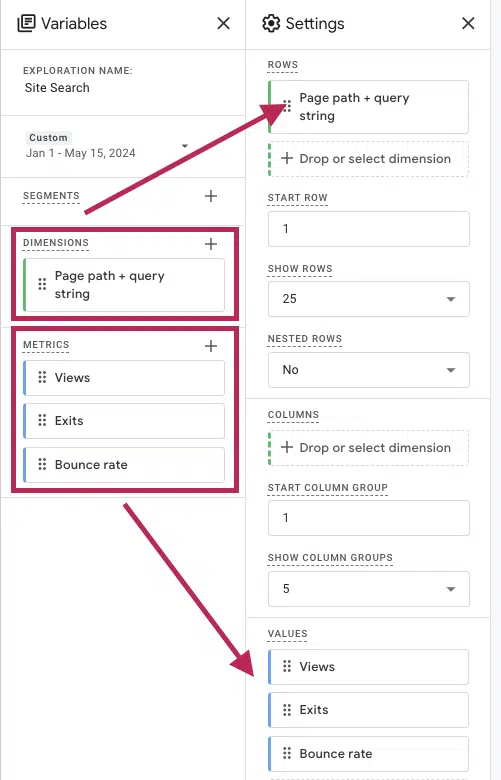

To limit your data to only contain site search queries, create a Page path + query string filter using your search term query parameter.
To check your parameter, perform a search on your site. Your parameter will be the text between the question mark and the equal sign in your search term’s URL.
For example, the parameter in the Google merch store is “keyword.” To ensure your results only contain site search data, include the surrounding question mark and equal sign in your filter.
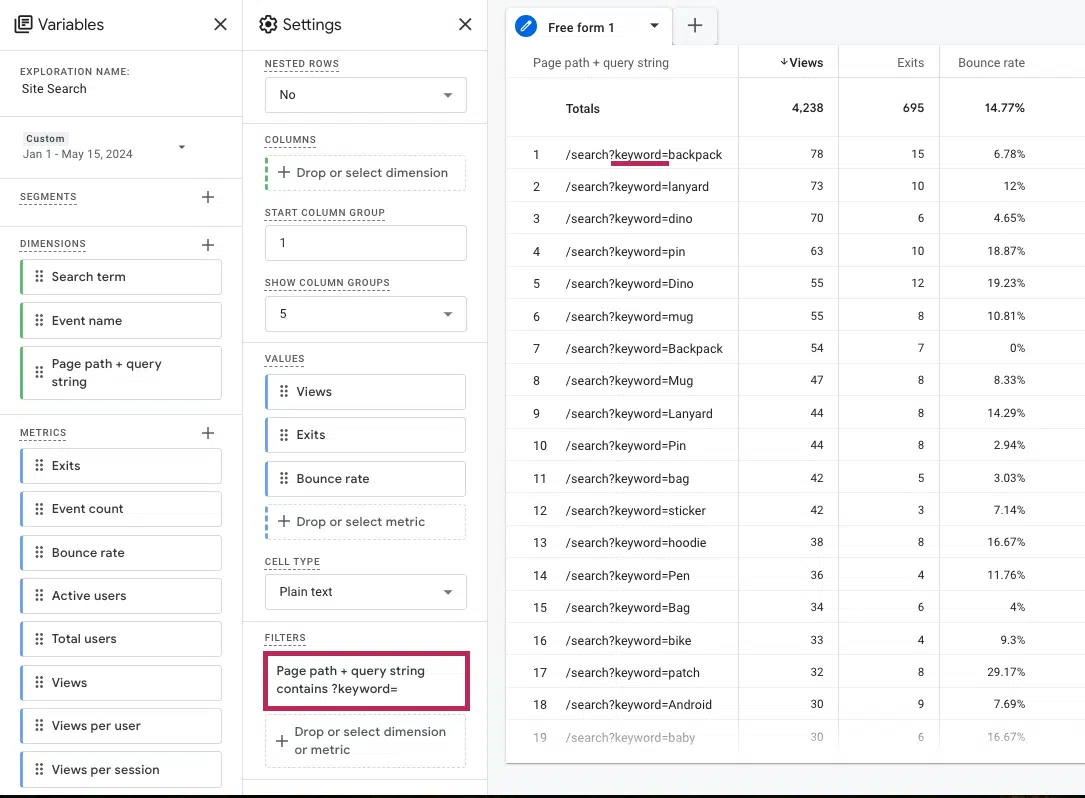

Now, turn your report into a heatmap by changing its cell type. Look for search terms with a high number of views, but also a high bounce rate and exit count.
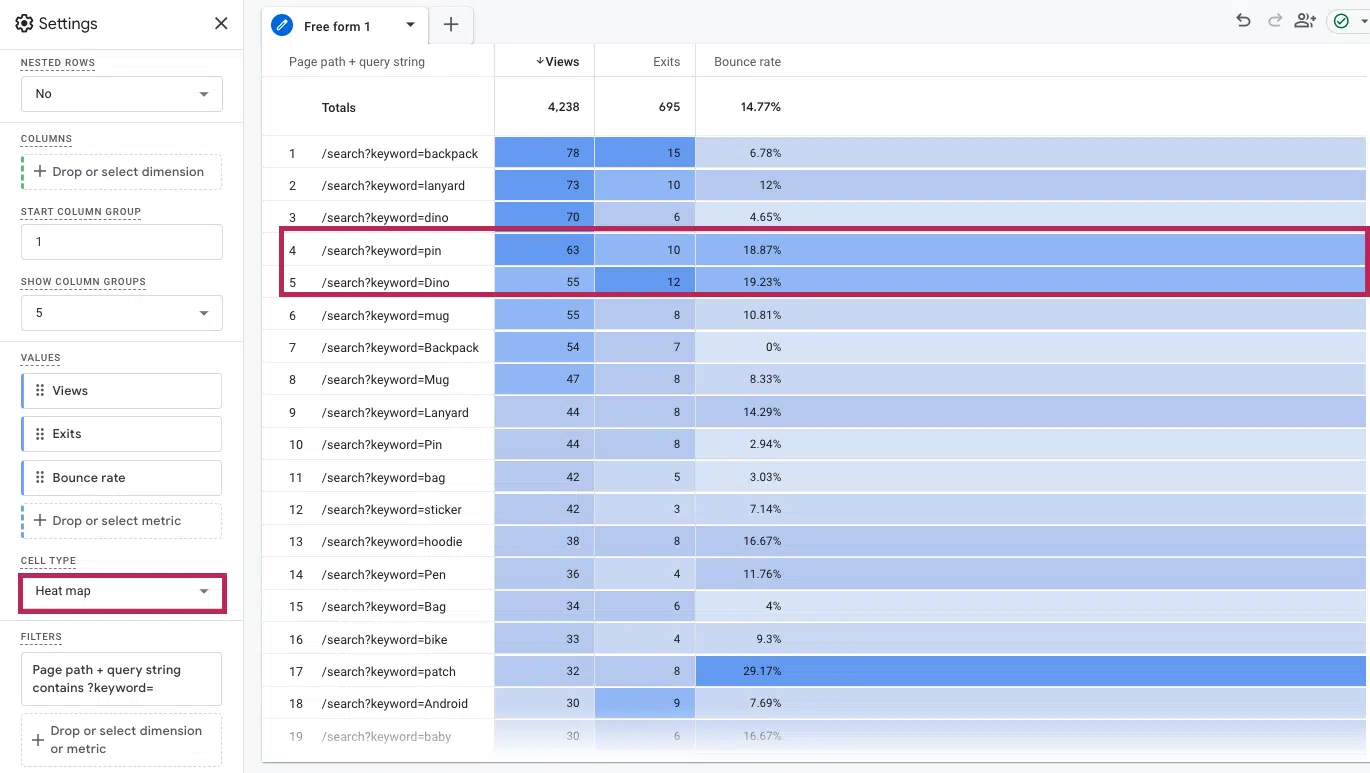

Try searching for these terms on your site and see what comes up. If it isn’t what you expected, consider building them into your knowledge base.
Other places to look for knowledge base content inspiration
If you don’t have any site search data yet or have already optimized your knowledge base based on the data in your exploration report, here are a few additional places to look for knowledge base article ideas.
Find troubleshooting needs on social media and review forums
Customers frequently flock to online communities and review outlets to express their confusion or frustration.
Social listening can help you identify your audience’s troubleshooting needs.
Even if a dissatisfied customer doesn’t directly engage with your company’s social media accounts, they may still air their dissatisfaction on a third-party review site or submit their question to an online community like Reddit.
Gain tutorial ideas from influencers and industry experts
No matter what your industry is, chances are you can learn something new about it from a TikTok or YouTube video.
Following influencers or experts in your industry can give you some great ideas for your own content.
While their tutorials may not be specific to your product, you might be able to apply some of the concepts they discuss to your own how-to guides.
Look to your competitors for inspiration
When was the last time you performed a content gap analysis?
Your knowledge base can help you fill content gaps you might not be able to fill with your blog alone and can also enhance the value of your existing blog posts by offering actionable next steps.
The best keywords for knowledge base articles are “how to” questions with informational intent.
Ask for (and respond to) user feedback
Direct user feedback can uncover some surprising insights you might not find in your analytics data.
Review feedback form submissions, look for common themes in customer support tickets and ask your customer-facing teams (sales, customer support, customer success, etc.) if they find themselves answering any questions over and over again.
Responding to user feedback with knowledge base articles will make your customers feel heard, enhance your onboarding process and improve your brand’s relatability.
Get the daily newsletter search marketers rely on.
How to create an SEO-friendly knowledge base
A knowledge base with logical and intuitive information architecture (IA) simplifies a user’s quest for answers while also jumpstarting the next stage in their self-education.
From a technical SEO perspective, a clear IA helps search engine crawlers find, index and contextualize your content. A few best practices for knowledge base IA:
Make your knowledge base easy for search engines to crawl
- Establish a clear knowledge base taxonomy with categories, subcategories and tags.
- Help crawlers (and users) navigate and contextualize your content with breadcrumbs that follow the structure of your URL path.
- Create a web of interconnected content and prevent orphan pages by adding a “related articles” section at the end of each article.
- Preserve crawl budget and avoid keyword cannibalization by consolidating similar content and canonicalizing duplicate content.
Bonus tip: If you have a large knowledge base or want to build in scalability, consider using a subdomain like help.yourwebsite.com.
Make your knowledge base easy for search engines to understand
- Build a knowledge graph to optimize for entity-based search. (See: “Entity-oriented search: The evolution of information retrieval, explained” for detailed instructions.)
- Implement structured data markup to give search engine crawlers explicit details about how to classify your knowledge base content.
- Maintain recency by updating your knowledge base to reflect new products and features.
- Maintain relevancy by updating your knowledge base to include version updates and changes to processes.
How to create a user-friendly knowledge base
Because users visit your knowledge base looking for specific, actionable information, your knowledge base content should get to the point quickly and simply.
Save the conversational introduction and flowery language for your blog. Reduce time to value by providing answers upfront. To build a knowledge base your users will love:
Make your knowledge base easy for users to find
- Make your help center accessible from your website’s navigation menu and customer support page, link to it on your social media accounts and online communities and integrate it with your onboarding process.
- Optimize your knowledge base articles for site search by incorporating user query keywords.
- Prominently display your most popular knowledge base articles under your search bar.
- Implement a chatbot to suggest knowledge base articles based on user queries.
Make your knowledge base articles easy for users to read
- Standardize and templatize your different article types, creating a predictable and chronological structure of headings and subheadings. For a troubleshooting article, for example, you might follow the following format: X problem, X solution, step-by-step instructions to get from problem to solution, related articles.
- Include anchor links in a table of contents to help users quickly navigate long articles.
- Follow web accessibility best practices, including ensuring proper contrast ratios, including alt text on all non-text media and using descriptive text for links.
- Offer multilingual support if you serve users in multiple countries (but don’t forget to follow hreflang best practices!).
Knowledge base examples to inspire you
Ready to take your knowledge base from ideation to creation? Check out these best-in-class examples for some additional guidance.
Information architecture: Shopify
The Shopify help center offers a delightful experience for both users and search engine crawlers. Their categories and subcategories are easy to understand and organized logically within a minimalist interface.
They also prominently display a chatbot to help users find what they need or connect them with a member of customer support.


The articles in each section of Shopify’s knowledge base act as categories with high-level information. Each article includes a dropdown menu with a table of contents guiding users to subcategories with more specific information.
For example, the Migrate to Shopify article’s dropdown menu allows users to choose platform-specific migration instructions.
As users continue navigating the help center, Shopify leaves breadcrumbs so they can return to previous pages if desired.
They also include previews – in the form of a table of contents – of the step-by-step instructions their articles will cover.
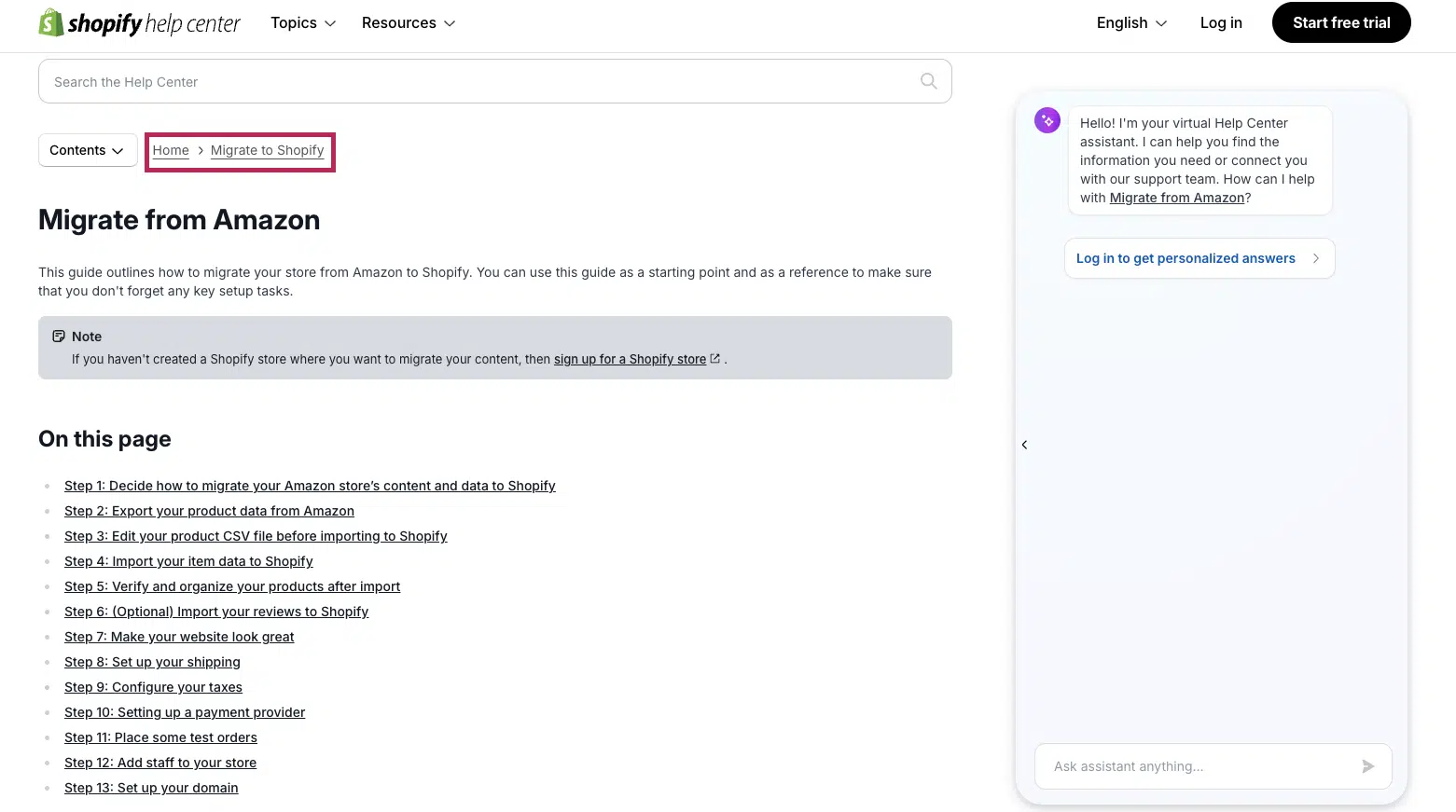

The virtual assistant remains on screen the entire time in case additional help is required.
Site search optimization: Dropbox
Dropbox clearly designed its knowledge base around what users search for in their help center. Their FAQs come up the moment users click on their help center’s search bar.
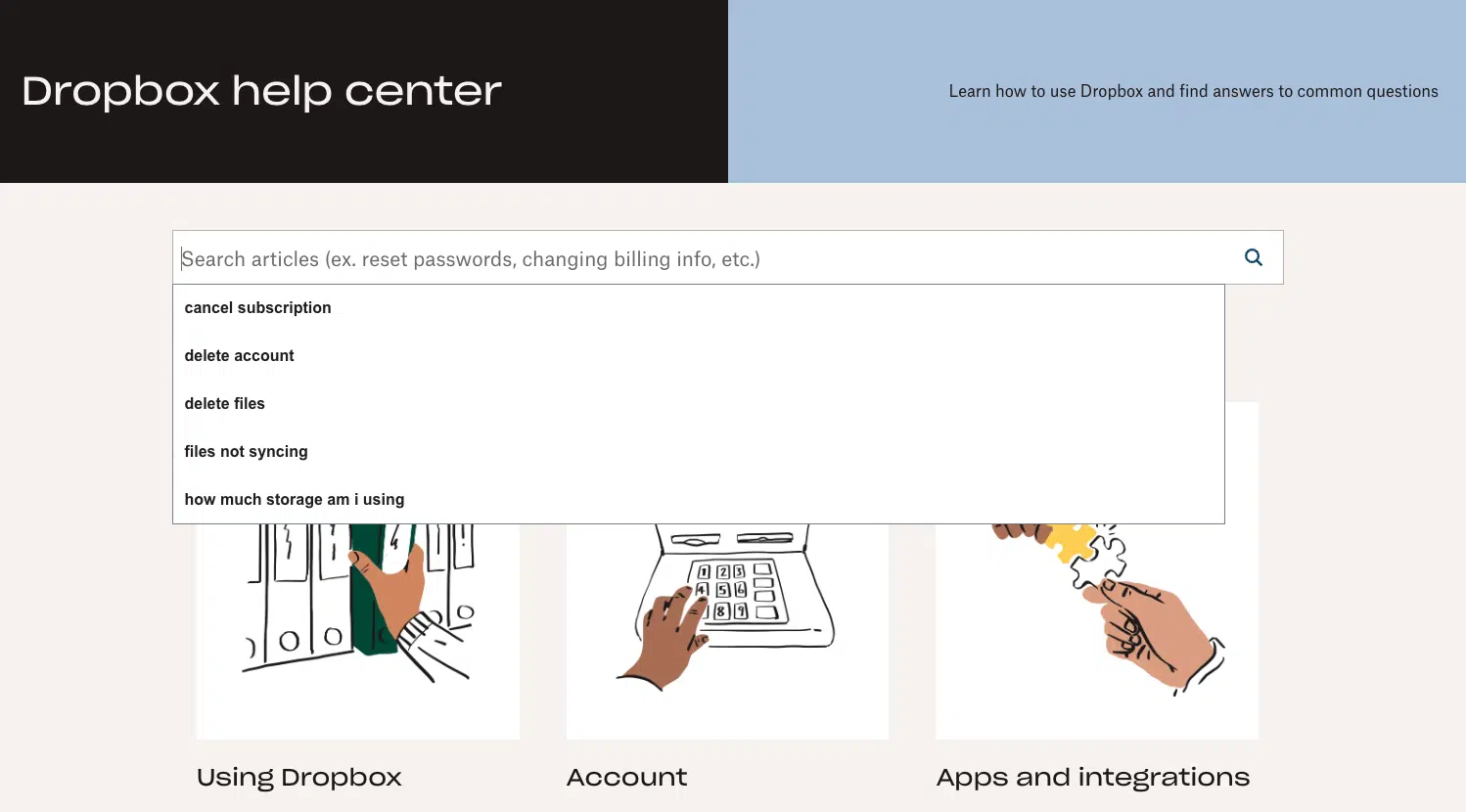

As a user begins to type, Dropbox auto-suggests potential queries. Their suggestions don’t just show up in alphabetical order based on what you type in the search box, either. They’ve clearly put thought into displaying queries based on internal search data.
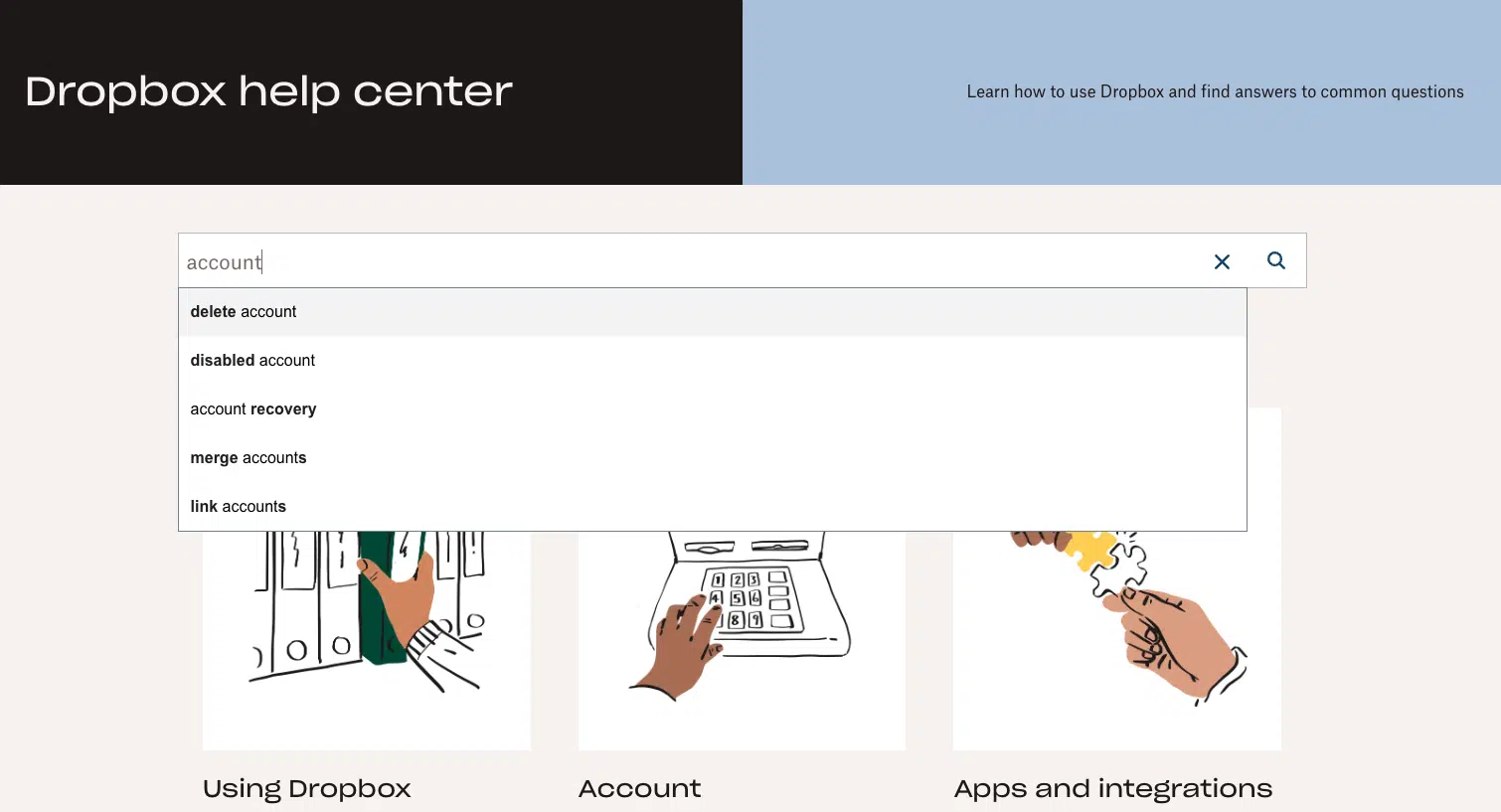

The ‘getting started’ guide: Trello
Your “getting started” guide should provide new users with basic setup instructions without overwhelming them. This resource from Trello, for example, covers all the essentials for using their project management platform, including:
- A brief welcome message.
- Basic product features (and how to locate them).
- Account settings (and how to modify them).
- Onboarding instructions.
- Top tips and tricks.


Take note of the navigation menu on the left side. When the user views different chapters within the guide, the navigation menu expands to include anchor links matching the headings of the questions answered within the chapter. The articles are also enhanced with screenshots and related article suggestions.
Trello highlights “pro tips” in purple boxes to encourage users to try additional workflow optimizations once they’ve mastered the basics.
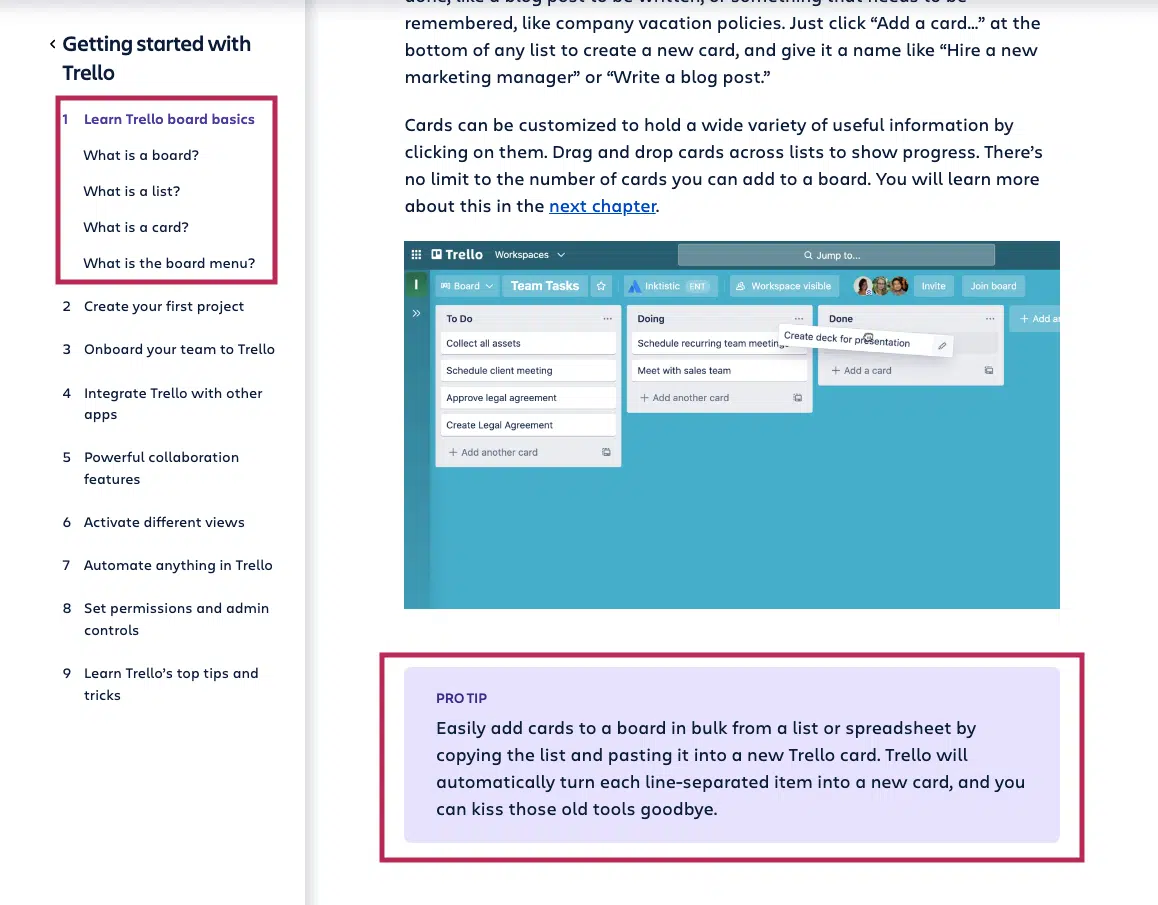

The FAQs: Airbnb
Your answers to the most common user questions should be displayed in a prominent place within your help center. Making these knowledge base articles easy to find creates a better user experience by shortening the user journey within your knowledge base.
Airbnb’s FAQ integration is a standout example of how FAQs can be used to establish brand loyalty by making users feel heard.
Airbnb segments their help center resources by their different audiences: guests, hosts, experience hosts and travel admin. With the click of a tab, the featured guides and top articles change to match the intended audience.
For guests, the Airbnb journey starts with finding the perfect lodging and how to check the reservation status.
For hosts, getting paid is most important, so it makes sense for cancellation policies to be a host FAQ.
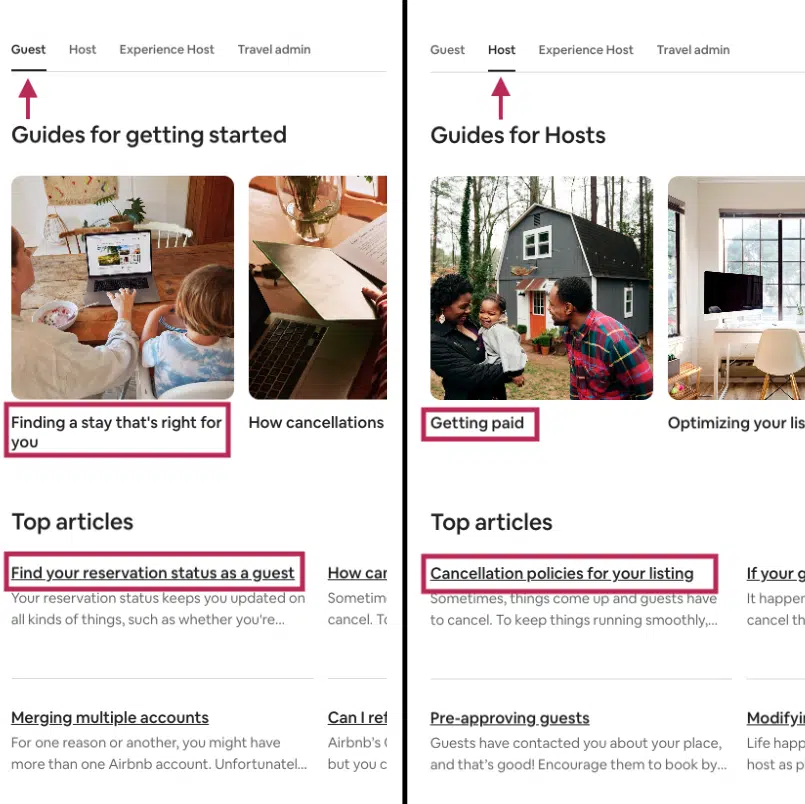

The multimedia how-tos: Canva
Given its purpose as a visual design tool, it’s no surprise Canva offers an extensive array of multimedia how-to guides, product documentation and tutorials to help both new and experienced users master their tools.
Canva’s design school contains thousands of courses and tutorials. Videos include text transcripts and give users the ability to skip ahead to a specific step in the instructions, making them both accessibility-friendly and easy to navigate.
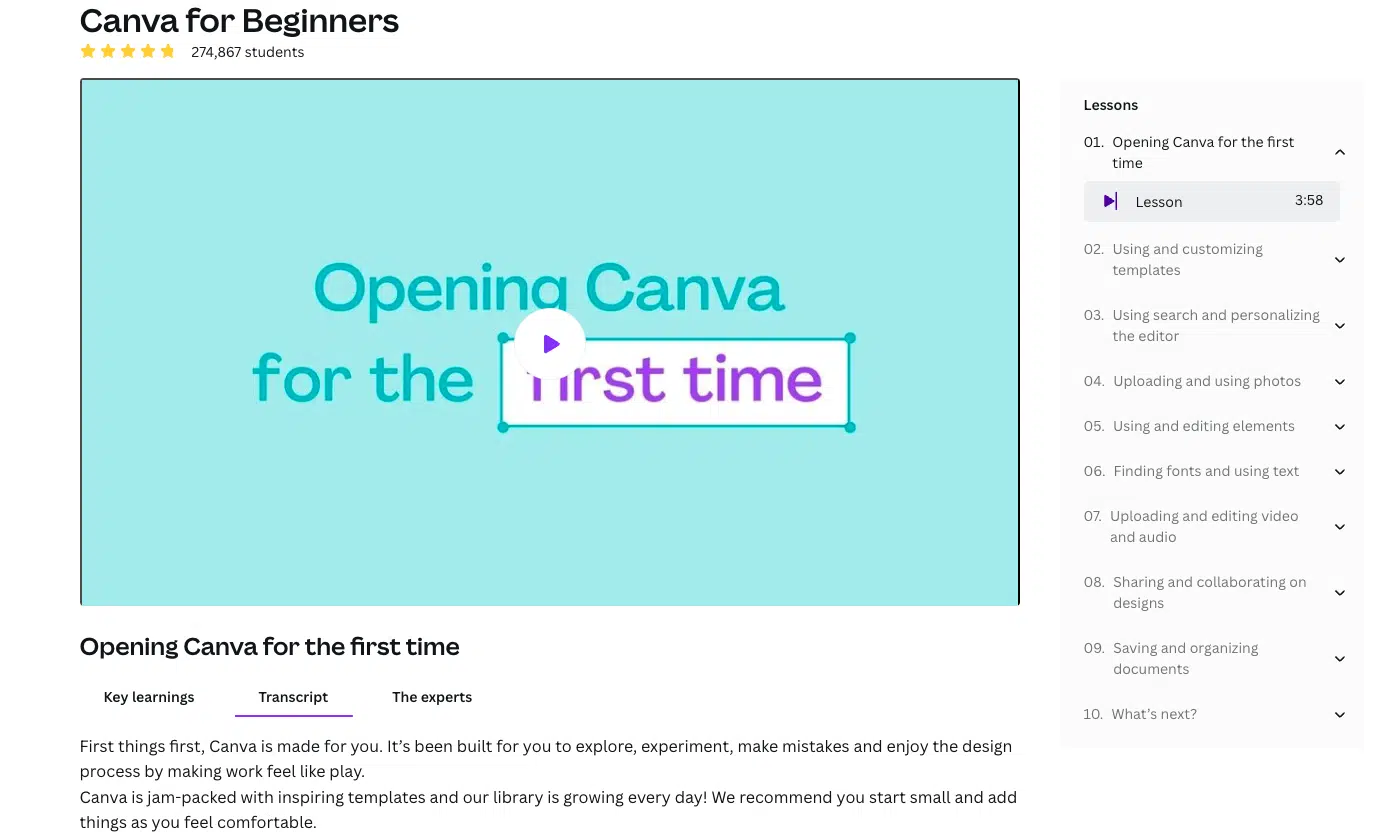

Building an SEO-friendly, user-friendly knowledge base requires careful thought and planning. Skillful implementation, however, can improve user satisfaction and boost your brand’s search engine visibility.
Contributing authors are invited to create content for Search Engine Land and are chosen for their expertise and contribution to the search community. Our contributors work under the oversight of the editorial staff and contributions are checked for quality and relevance to our readers. The opinions they express are their own.
